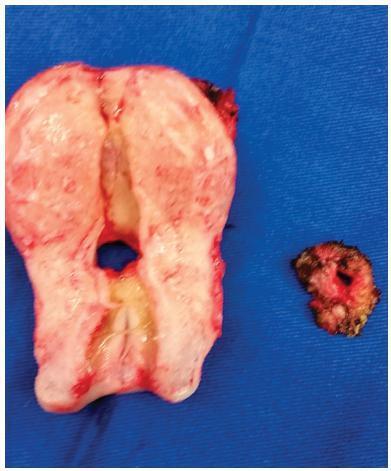Summary
Revista Brasileira de Ginecologia e Obstetrícia. 2020;42(8):448-453
To analyze the rates of cesarean delivery longitudinally in a university hospital using the Robson classification.
Data related to births performed between 2014 and 2018 and recorded in the Maternal and Neonatal Health Information System (Sistema de Informações em Saúde Materna e Neonatal, SISMATER, in Portuguese) were analyzed using the Robson classification. As an aid, we used articles published in the last five years that approach the same topic in other Brazilian maternity hospitals; they were retrieved from the LILACS, MEDLINE, CINAHL, Scopus, Web of Science and Cochrane Library databases.
There was little variation in the total rate of cesarean sections in the period; however, the profile of each group changed over the years. It was possible to verify a significant reduction in the participation of groups of pregnant women with lower risk and an increase in high-risk pregnancies, attributable to the decrease in beds in the institution, with a greater transfer of patients. In addition, there was a reduction in cesarean sections among the lower-risk groups,while the rate among the higher-risk groups remained stable.
The use of the Robson classification to stratify cesarean deliveries contributes to a better analysis of the indications for cesarean delivery, enabling the establishment of strategies to reduce the rates, generating a positive impact on hospital management and quality of care.

Summary
Revista Brasileira de Ginecologia e Obstetrícia. 2020;42(6):310-315
The Robson 10 group classification system (RTGCS) is a reproducible, clinically relevant and prospective classification system proposed by the World Health Organization (WHO) as a global standard for assessing, monitoring and comparing cesarean section (CS) rates. The purpose of the present study is to analyze CS rates according to the RTGCS over a 3-year period and to identify the main contributors to this rate.
We reviewed data regarding deliveries performed from 2014 up to 2016 in a tertiary hospital in Portugal, and classified all women according to the RTGCS. We analyzed the CS rate in each group.
We included data from 6,369 deliveries. Groups 1 (n = 1,703), 2 (n = 1,229) and 3 (n = 1,382) represented 67.7% of the obstetric population. The global CS rate was 25% (n = 1,594). Groups 1, 2, 5 and 10 were responsible for 74.2% of global CS deliveries.
As expected, Groups 1, 2, 5 and 10 were the greatest contributors to the overall CS rate. An attempt to increase the number of vaginal deliveries in these groups, especially in Groups 2 and 5, might contribute to the reduction of the CS rate.
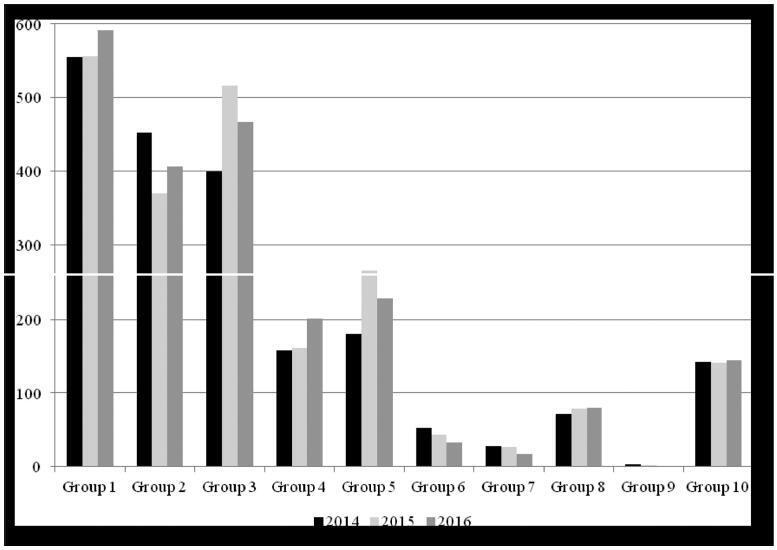
Summary
Revista Brasileira de Ginecologia e Obstetrícia. 2020;42(4):181-187
To evaluate the ability of the pubic arch angle (PAA) as measured by transperineal ultrasonography during labor to predict the delivery type and cephalic pole disengagement mode.
The present prospective cross-sectional study included 221 women in singleton-gestational labor ≥ 37 weeks with cephalic fetuses who underwent PAA measurement using transperineal ultrasonography. These measurements were correlated with the delivery type, cephalic pole disengagement mode, and fetal and maternal characteristics.
Out of the subjects, 153 (69.2%) had spontaneous vaginal delivery, 7 (3.2%) gave birth by forceps, and 61 (27.6%) delivered by cesarean section. For the analysis, deliveries were divided into two groups: vaginal and surgical (forceps and cesarean). The mean PAA was 102 ± 7.5º (range, 79.3-117.7º). No statistically significant difference was observed in delivery type (102.6 ± 7.2º versus 100.8 ± 7.9º, p = 0.105). The occipitoanterior position was seen in 94.1% of the fetuses and the occipitoposterior position in 5.8%. A narrower PAA was found in the group of surgical deliveries (97.9 ± 9.6º versus 102.6 ± 7.3º, p = 0.049). Multivariate regression analysis showed that PAA was a predictive variable for the occurrence of head disengagement in occipital varieties after birth (odds ratio, 0.9; 95% confidence interval, 0.82-0.99; p = 0.026).
Ultrasonographic measurement of the PAA was not a predictor of delivery type, but was associated with the persistence of occipital varieties after birth.
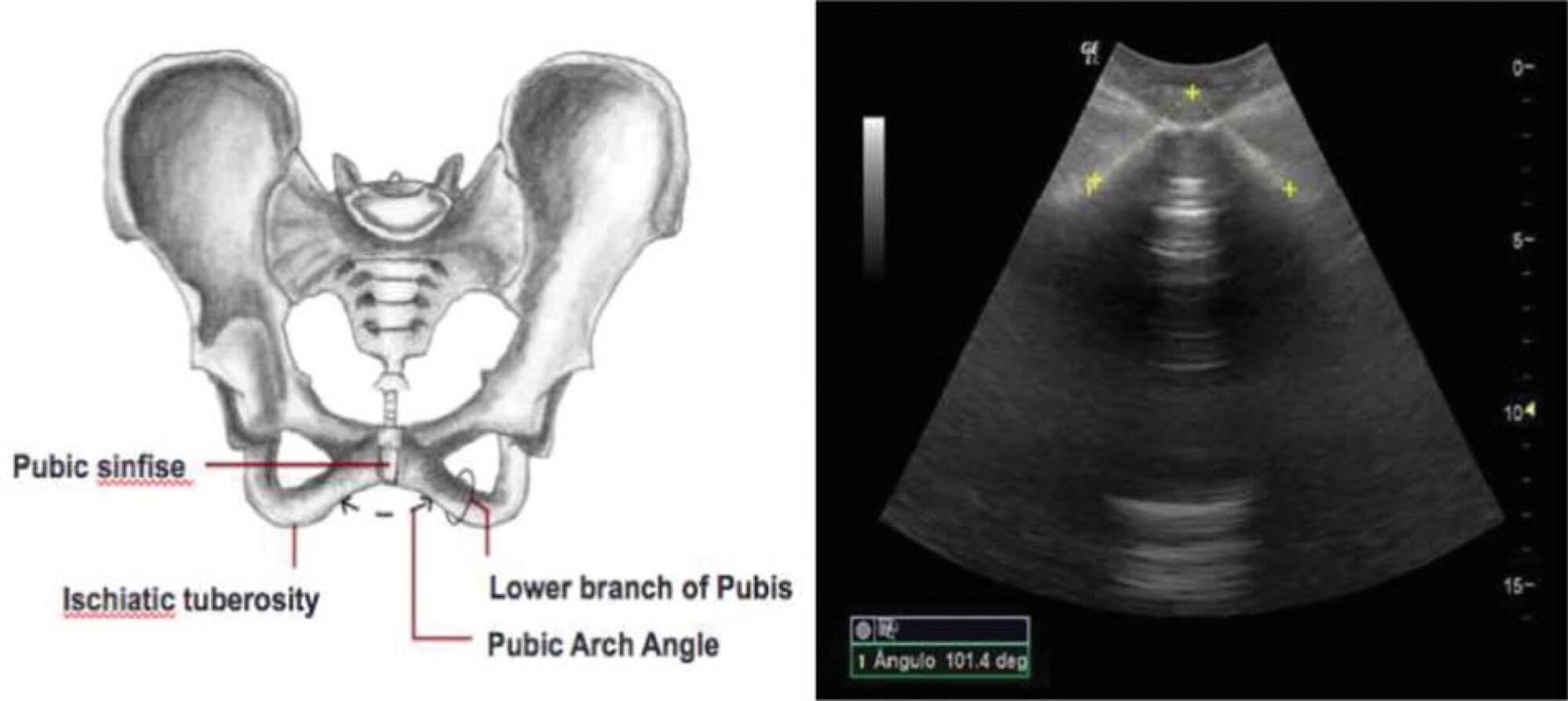
Summary
Revista Brasileira de Ginecologia e Obstetrícia. 2019;41(12):682-687
The present study aims to understand to what extent obesity is related to adversematernal, obstetrical, and neonatal outcomes in a Portuguese obstetrical population.
A retrospective case-control study was conducted at the Department of Obstetrics of a differentiated perinatal care facility. The study compared 1,183 obese pregnant womenwith 5,399 normal or underweight pregnantwomen for the occurrence of gestational diabetes, hypertensive pregnancy disorders, and preterm birth. Mode of delivery, birthweight, and neonatal intensive care unit (ICU) admissionswere also evaluated. Mean blood glucose values were evaluated and compared between groups, in the first and second trimesters of pregnancy. Only singleton pregnancies were considered.
The prevalence of obesity was 13.6%. Obese pregnant women were significantly more likely to have cesarean sections (adjusted odds ratio [aOR] 2.0, p< 0.001), gestational diabetes (aOR 2.14, p< 0.001), hypertensive pregnancy disorders (aOR 3.43, p< 0.001), and large-for-gestational age ormacrosomic infants (aOR 2.13, p< 0.001), and less likely to have small-for-gestational age newborns (aOR 0.51, p< 0.009). No significant differences were found in terms of pretermbirths, fetal/neonatal deaths, low birthweight newborns, and neonatal ICU admissions among cases and controls. Maternal obesity was significantly associated with higher mean blood glucose levels, in the first and second trimesters of pregnancy.
Obesity is associated with increased risks of adverse pregnancy and neonatal outcomes. These risks seem to increase progressively with increasing body mass index (BMI) class. Female obesity should be considered a major public health issue and has consequences on maternal-fetal health.
Summary
Revista Brasileira de Ginecologia e Obstetrícia. 2019;41(8):485-492
Themoment of admission for deliverymay be inappropriate for offering an intrauterine device (IUD) to women without prenatal contraception counseling. However, in countries with high cesarean rates and deficient prenatal contraception counseling, this strategy may reduce unexpected pregnancies and repeated cesarean sections.
This was a prospective cohort study involving 100 women without prenatal contraception counseling. Postplacental IUD was offered after admission for delivery and placed during cesarean. The rates of IUD continuation, uterine perforation, and endometritis were assessed at 6 weeks and 6 months, and the proportion of women continuing with IUD at 6 months was assessed with respect to the number of previous cesareans.
Ninety-seven women completed the follow-up. The rate of IUD continuation was 91% at 6 weeks and 83.5% at 6 months. The expulsion/removal rate in the first 6 weeks was not different from that between 6 weeks and 6 months (9 vs 9.1%, respectively). There were 2 cases of endometritis (2.1%), and no case of uterine perforation. Among 81 women continuing with intrauterine device after 6-months, 31% had undergone only the cesarean section in which the IUD was inserted, 44% had undergone 2 and 25% had undergone 3 or more cesarean sections.
Two thirds of the women who continued with IUD at 6 months had undergone 2 ormore cesarean sections. Since offering trial of labor is unusual after 2 or more previous cesareans, we believe that offering IUD after admission for delivery may reduce the risk of repeated cesarean sections and its inherent risks.
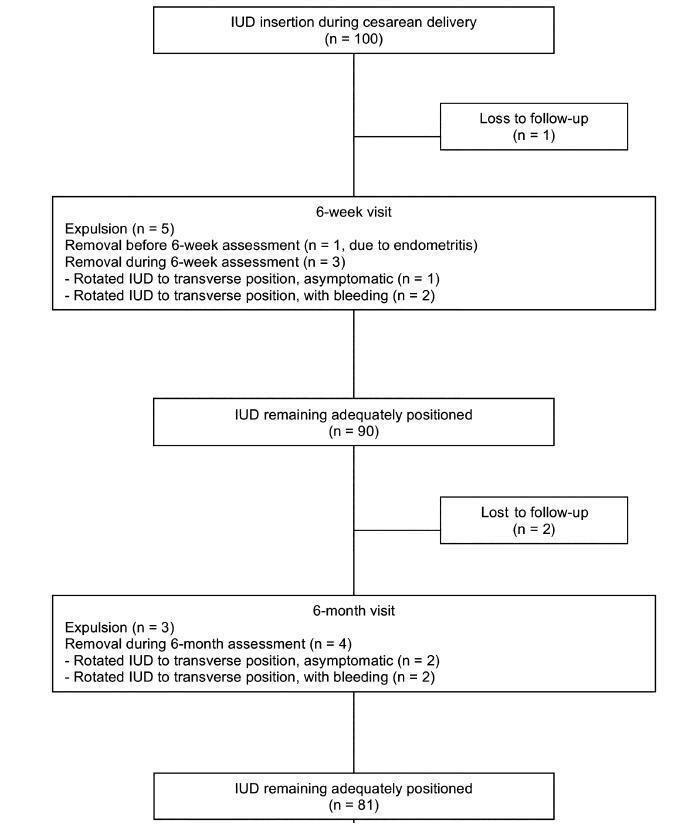
Summary
Revista Brasileira de Ginecologia e Obstetrícia. 2019;41(6):363-370
To evaluate the results of induced labor and to determine the main factors associated with intrapartum cesarean section after patients being submitted to this procedure at the Hospital Universitário of the Universidade Federal de Santa Catarina (HU/UFSC, in the Portuguese acronym), Florianópolis, state of Santa Catarina, Brazil.
A retrospective cross-sectional study that included all the pregnancies that resulted in single-fetus births, whose gestational-age was > 22 weeks and that had been submitted to labor induction at the HU/UFSC in the period from 2013 to 2016.
During the proposed period, 1,491 pregnant women were submitted to the labor induction protocol. In 1,264 cases (84.8%), induction resulted in labor, with 830 (65.7%) progressing to vaginal delivery. Gestational age ≥ 41 + 0 weekswas themost common indication for induced labor (55.2%), and vaginal administration of misoprostol was themost commonly usedmethod (72.0%). Among these pregnant women, the cesarean section rate was of 34.3%. Considering the cases of induction failure, the cesarean section rate rose to 44.3%. The factors associated with cesarean section were: previous history of cesarean delivery (PR [prevalence ratio] = 1.48; 95%CI [confidence interval]: 1.51-1.88), fetuses with intrauterine growth restriction (IUGR) (PR = 1.82; 95%CI: 1.32-2.19), Bishop score ≤ 6 (PR = 1.33; 95%CI: 1.01-1.82), and induction time either < 12 hours (PR = 1.44; 95%CI: 1.17-1.66) or > 36 hours (PR = 1.51; 95% CI 1.22-1.92) between the beginning of the induction and the birth.
Labor induction was successful inmost patients. In the cases in which the final outcome was a cesarean section, the most strongly associated factors were: previous history of cesarean delivery, presence of fetuses with IUGR, and either excessively short or excessively long periods of induction.
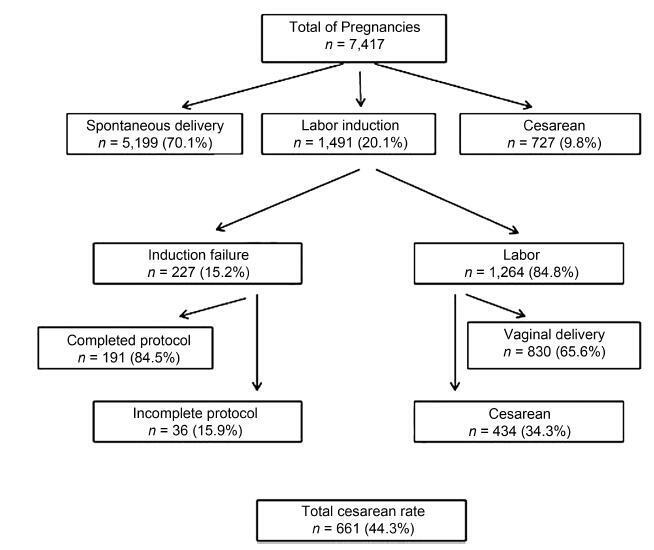
Summary
Revista Brasileira de Ginecologia e Obstetrícia. 2018;40(9):513-517
Induction of labor (IL) is a common obstetric procedure, but it is questionable whether or not it results in higher cesarean section (CS) rates. The present study aims to evaluate the impact of IL in the overall CS rates and to analyze these rates according to the method of IL employed and to the Robson group in which it was applied.
We have conducted a retrospective study including pregnant women whose labor was induced at a tertiary hospital in 2015 and 2016. All women were classified according to the Robson Classification System (RCS). The CS rates were analyzed and compared regarding the method of IL employed.
A total of 1,166 cases were included. The CS rate after IL was 20.9%, which represented 23.1% of the total of CSs performed in 2015 and 2016. The highest CS rates were recorded in RCS groups 5 (65.2%) and 8 (32.3%). Group 2 was the highest contributor to the overall CS rate, since it represented 56.7% of the population. The intravaginal prostaglandins method was the most used (77%). Transcervical Foley catheter was the preferredmethod in group 5 and intravaginal prostaglandins in all the other groups. The CS rate was higher when transcervical Foley catheter was used (34.1%).
Transcervical Foley catheter induction was associated with a higher rate of CS, probably because it was the preferred method used in group 5.
Summary
Revista Brasileira de Ginecologia e Obstetrícia. 2018;40(9):563-569
To describe a case of vesicouterine fistula and to review the literature related to this condition.
For the review, we accessed the MEDLINE, BIREME and LILACS databases; the references of the searched articles were also reviewed.
A 38-year-old woman, in the 1st day after her 3rd cesarean, presented heavy hematuria, which was considered secondary to a difficult dissection of the bladder. A total of 6 months after delivery, she failed to resume her regular menstrual cycles and presented cyclic menouria and amenorrhea. At this time, she had two episodes of urethral obstruction by blood clots. She remained without a correct diagnosis until about two years postdelivery, when a vesicouterine fistula was confirmed through cystoscopy. A surgical correction through open abdominal route, coupled with hysterectomy, was performed. After the surgery, the symptoms disappeared. The review showed a tendency of change in the relative frequency of the different types of genitourinary fistulae. Vesicovaginal fistulae, usually caused by inadequate care during labor, are becoming less frequent than those secondary tomedical procedures, such as vesicouterine fistulae. The most common cause of this latter kind of fistula is cesarean section, especially repeated cesarean sections. The diagnosis is confirmed through one or more imaging exams, or through cystoscopy. The most common treatment is surgical, and the routes are: open abdominal, laparoscopic, vaginal or robotic. There are some reports of success with the conservative treatment.
Vesicouterine fistulae are becoming more common because of the increase in the performance of cesarean sections, and the condition must be considered a possible complication thereof.
